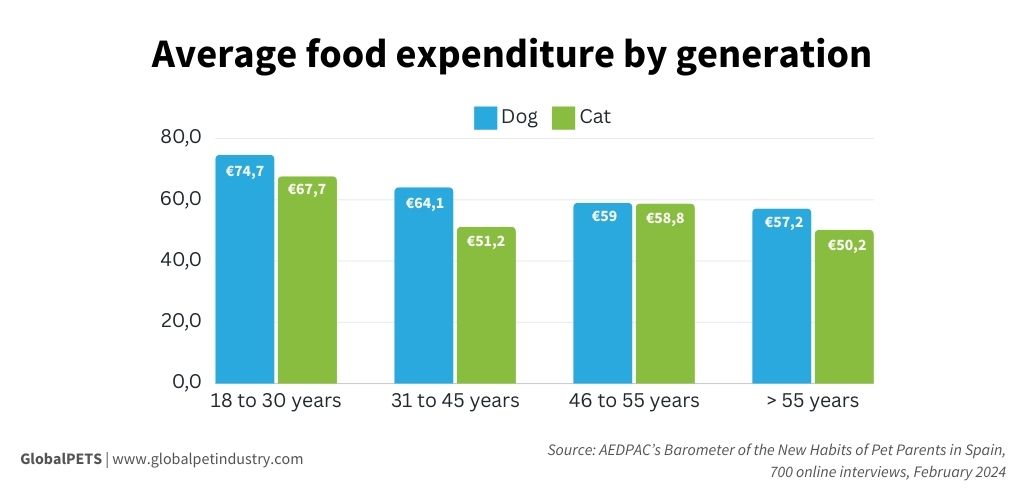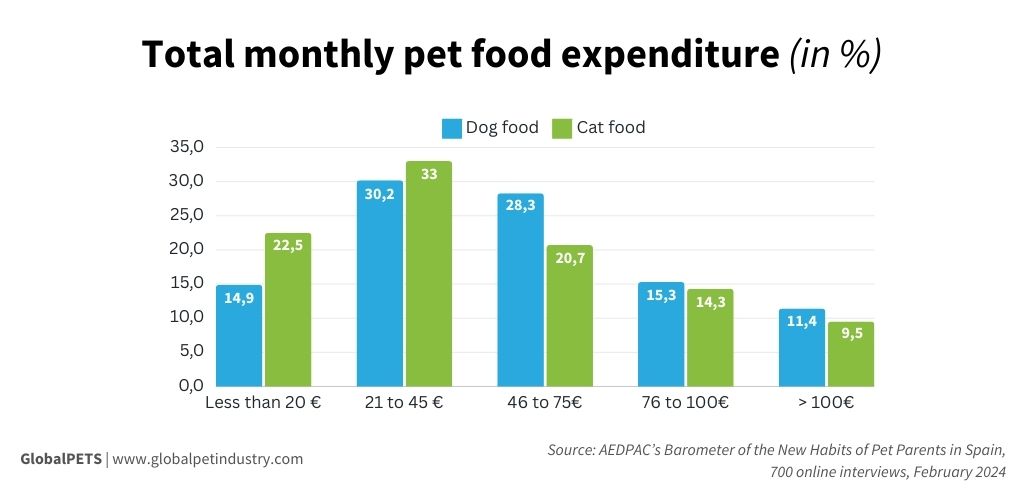Analysis: Diving into Spanish pet parents’ generational gap

Do younger pet parents spend more? What are their shopping habits? A new study unveils the differences.
With 49% of Spanish households owning a pet, the country is one of the largest markets in Europe. According to the European Pet Food Industry Federation (FEDIAF), its dog population is just below that of Germany and the UK.
The importance of pets in Spaniards’ lives can be seen in the fact that most have owned a pet at some point. A study by the Spanish Association of Distributors of Pet Products (AEDPAC) shows that only 22% of those who have pets are first-timers.
However, age reveals differing attitudes toward pets regarding feeding habits, expenses and even holidays.
Feeding and spending differences
The study analyzes pet parents by generation and highlights differences in purchasing behaviors. The youngest generation (18 to 30 years old) is the most likely to spend over €100 ($108.74) on pet food. Whether they own a cat or a dog also plays a role.
Overall, pet parents 30 and younger are the biggest spenders on both their dogs and cats. On average, they shell out €74.70 ($81.23) per month per dog, with pet parents aged 31–45 spending €61 ($66.33) monthly. Interestingly, those aged 18-30 also have the highest proportion of pet parents forking out over €100 ($108.74) per month on dog food (16.8%).
When it comes to spending, pet parents over 55 are the generation with the deepest pockets for cat food. In fact, over 1 in 10 (11.3%) spend over €100 ($108.74) on cat food—the highest among all generations. A generation of contrasts, this is also the most frugal, with nearly 3 out of 10 spending less than €20 ($21.75) per month on their felines.
In terms of overall monthly expenditure, Spanish pet parents aged 18-30 rank the highest in their monthly cat food spending, with an average of €67.70 ($73.62). They are also the generation that spends the most (25%) in the €76–€100 ($82.64–$108.74) bracket for cat food.
Regarding the type of food, dog parents are most likely to change the diet they currently feed their pets, with 12% planning to do so this year. By age group, the youngest generation has the highest proportion of owners considering a diet switch this year (24%).
The proportion for cat owners is far lower—only 4% plan to switch their dogs’ food this year. Among these, 15% of pet parents aged 46–55 are most likely to do so.
Pet ownership information
So, where do pet parents get their information from? While vets are among the most trusted professionals (69%), they are particularly trusted by the older generation of 55+ (77%). Pet shops come second, with 42% of pet parents making use of them.
Unsurprisingly, social media (23%), TV shows (16%) and apps (18%) are more popular with those under 30. This group and those aged 31–45 (16%) also use online forums.
Work and holidays
There is no doubt that all pet parents love their cats and dogs. However, there is a generational gap regarding taking pets to work.
While 60% of the pet parents aged less than 30 would like to take their furry friends to work, the proportion drops to 33% in the 46 to 55-year-old group, the lowest among all age groups. Conversely, both this group and those 55 and above wouldn’t like it at all (35% and 29% respectively).
A similar division can be seen when it comes to holidays. The over 55s are least likely to take pets traveling with them—36% don’t take their pets on holidays—whereas this number drops to 21% among the younger generation. This group also values pet-friendly hotels the most (48%).
Although almost two-thirds (65%) of pet parents have never considered hiring a trainer, this number is higher among pet parents of more than 55 years old (73.8%) who have never engaged with one.
In contrast, the younger generations are the most likely to have thought about it (31% for both generations up to 45 years old), but those 30 and younger have the highest proportion of owners who have actually hired one (15%).


